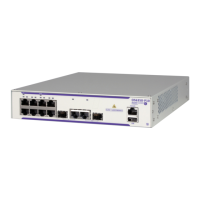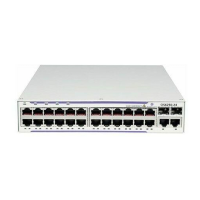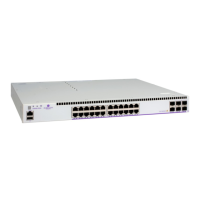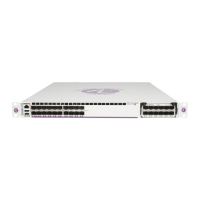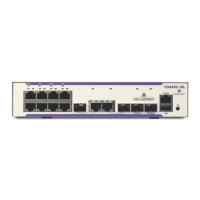Configuring VRRP VRRP Configuration Overview
OmniSwitch AOS Release 8 Network Configuration Guide December 2017 page 23-8
VRRP Configuration Overview
During startup, VRRP is loaded onto the switch and is enabled. Virtual routers must be configured and
enabled as described in the following sections. Since VRRP is implemented on multiple switches in the
network, some VRRP parameters must be identical across switches:
• VRRP and ACLs
If QoS filtering rules (Access Control Lists) are configured for Layer 3 traffic on a VRRP router, all of
the VRRP routers on the LAN must be configured with the same filtering rules; otherwise the security
of the network will be compromised. See Chapter 26, “Configuring QoS,” for more information about
filtering.
• Conflicting VRRP Parameters Across Switches
All virtual routers with the same VRID on the LAN should be configured with the same advertisement
interval and IP addresses. If the virtual routers are configured differently, it may result in more than
one virtual router acting as the master router. This in turn would result in duplicate IP and MAC
address messages as well as multiple routers forwarding duplicate packets to the virtual router MAC
address. Use the show vrrp|vrrp3 statistics command to check for conflicting parameters. For
information about configuring VRRP parameters, see the remaining sections of this chapter.
Basic Virtual Router Configuration
At least two virtual routers must be configured on the LAN—a master router and a backup router. The
virtual router is identified by a number called the Virtual Router ID (VRID), the VLAN on which the
virtual router is configured, and the IP address or addresses associated with the router. Multiple virtual
routers may be configured on a single physical VRRP router.
Basic commands for setting up virtual routers include:
vrrp|vrrp3
vrrp|vrrp3 address
The next sections describe how to use these commands.
Creating/Deleting a Virtual Router
There are two vrrp|vrrp3 command options for creating a virtual router:
• vrrp—creates a VRRPv2 virtual router for IPv4 addresses.
• vrrp3—creates a VRRPv3 virtual router for IPv6 addresses.
Both of these command options require a VRID and an existing VLAN ID to create the virtual router. The
VRID must be a unique number ranging from 1 to 255. The VLAN ID must be configured with an IPv4
interface (VRRPv2) or an IPv6 interface (VRRPv3).
For example, the following commands create a VRRPv2 virtual router with VRID 6 on VLAN 4 and a
VRRPv3 virtual router with VRID 10 on VLAN 5:
-> vrrp 6 4
-> vrrp3 10 5
In addition to the required VRID and VLAN ID, the following optional parameters may also be specified
when creating a VRRPv2 or VRRPv3 virtual router:

